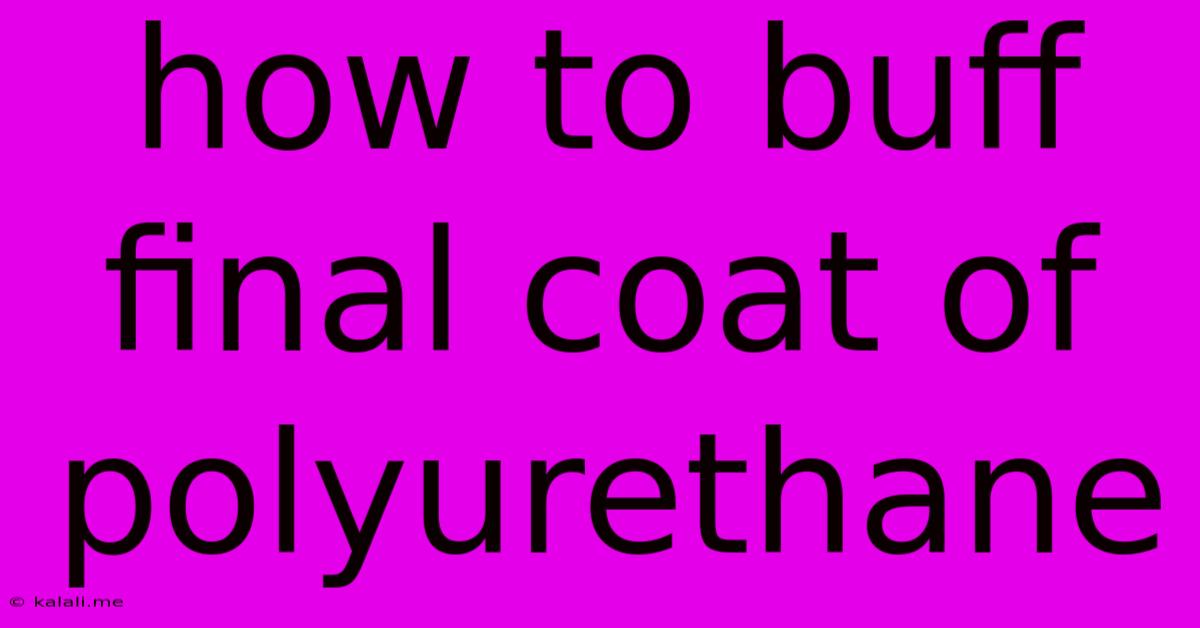How To Buff Final Coat Of Polyurethane
Kalali
May 23, 2025 · 3 min read

Table of Contents
How to Buff a Final Coat of Polyurethane for a Showroom Shine
Applying a final coat of polyurethane is the culmination of a woodworking project, promising a protective and beautiful finish. But achieving that coveted showroom shine requires more than just application; it demands proper buffing. This guide will walk you through the process of buffing your polyurethane finish to perfection, ensuring a flawless and durable surface. This involves understanding the type of polyurethane used, selecting the right tools, and mastering the buffing technique.
Why Buffing Matters: Buffing a polyurethane finish isn't merely cosmetic. It removes microscopic imperfections like dust nibs and orange peel, resulting in a smoother, more even surface. This enhanced finish is significantly more resistant to scratches and blemishes, improving the overall longevity and visual appeal of your project. A properly buffed polyurethane coat also showcases the underlying wood grain with greater clarity and depth.
Choosing Your Buffing Tools
The success of your buffing process hinges on selecting the appropriate tools. Avoid using abrasive materials that could scratch the finish. The best approach utilizes a soft, non-abrasive material combined with a gentle touch.
- Soft Cloth: A 100% cotton cloth, ideally a clean, lint-free t-shirt or microfiber cloth, is your primary tool. These are gentle enough to avoid scratching yet effective at removing minor imperfections.
- Buffing Pads: For larger surfaces, consider using a soft buffing pad attached to a rotary buffer. However, exercise extreme caution with a rotary buffer to avoid burning through the polyurethane. Start with the lowest speed setting and maintain light pressure.
- Rubbing Compound (Optional): For particularly stubborn imperfections, a very fine rubbing compound designed for polyurethane finishes can be used sparingly. Always test in an inconspicuous area first.
The Buffing Process: A Step-by-Step Guide
This process should be undertaken once the polyurethane is fully cured. This curing time varies depending on the type of polyurethane and environmental conditions, but generally ranges from 24 to 72 hours.
- Preparation is Key: Begin by cleaning the surface thoroughly. Remove any dust or debris with a tack cloth. A clean surface ensures a smooth buffing process.
- Start with Gentle Pressure: Use a clean, soft cloth. Apply light, even pressure in circular motions. Work in small sections, overlapping each pass to avoid missed areas. The goal is to smooth the surface, not to remove material.
- Assess and Adjust: Regularly inspect your work. If you encounter stubborn imperfections, carefully consider using a very fine rubbing compound. Again, test in an inconspicuous area before widespread application. Always apply sparingly and work it in using gentle circular motions.
- Multiple Passes: Be prepared to make multiple passes. Patience is crucial here. Several passes with a soft cloth will gradually reveal a high-gloss shine.
- Rotary Buffer (Use with Caution): If using a rotary buffer, maintain a low speed and light pressure. Never dwell in one area for too long. Excessive pressure or speed can damage the finish. Frequent breaks will prevent overheating and potential burning.
- Final Inspection: Once you've achieved the desired shine, inspect the entire surface thoroughly under bright light. Address any remaining imperfections with a fresh, clean cloth.
Types of Polyurethane and Buffing Considerations
The type of polyurethane used will influence the buffing process. Water-based polyurethanes typically require less buffing than oil-based polyurethanes, as they tend to self-level better. However, the principles outlined above apply to both types.
Maintaining Your Shine
After all the hard work, protect your beautiful finish. Regular dusting will prevent the accumulation of dirt and debris, minimizing the need for frequent buffing. Avoid harsh chemicals and abrasive cleaners.
By following these steps and employing patience, you can achieve a stunning, high-gloss finish that enhances the beauty and durability of your woodworking projects. Remember, a well-buffed polyurethane finish is a testament to your attention to detail and craftsmanship.
Latest Posts
Latest Posts
-
Linux Screen Status Bar Messed Up
May 23, 2025
-
My Is My Mouse In Minecraft So Slow
May 23, 2025
-
Words For Sounds Teeth Make When Hitting Something
May 23, 2025
-
Where Did Dogmeat Go Fallout 4
May 23, 2025
-
Why Does Melissa Mccarthy Wear Turtlenecks In The Boss
May 23, 2025
Related Post
Thank you for visiting our website which covers about How To Buff Final Coat Of Polyurethane . We hope the information provided has been useful to you. Feel free to contact us if you have any questions or need further assistance. See you next time and don't miss to bookmark.